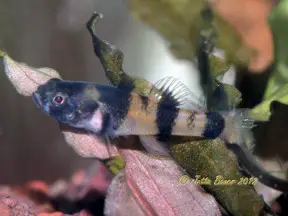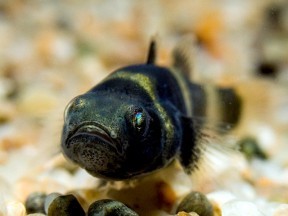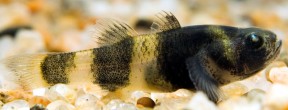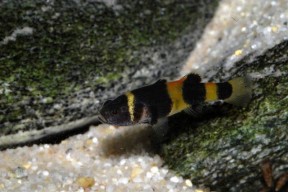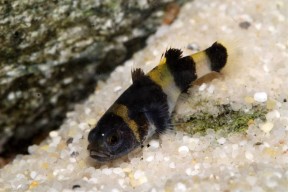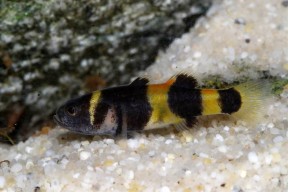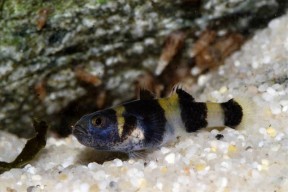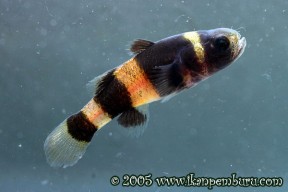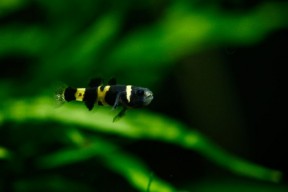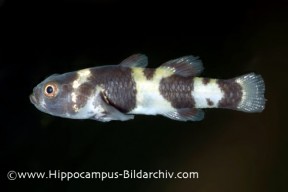Brachygobius sabanus
Sabanus Bumblebee Goby
Classification
Order: Perciformes Family: Gobiidae
Distribution
Type locality is given as ‘Lamag, Kinabatangan District, East Coast Residency, Malaysia’, which corresponds to Kinabatangan district in modern-day Sandakan Division, Sabah state, Malaysia (northeastern Borneo).
The full extent of its range is unclear but similar-looking fish have been recorded in Indonesian (Kalimantan, Borneo), Singapore, Peninsular Malaysia (Muar), and Thailand (Bangkok).
The populations in Singapore are not thought to be natural and some probably escaped from commerical breeding facilities while others may have been introduced with intent. The species was first recorded there in 2007 (Lim and Tan, 2012).
Habitat
Inhabits both fresh and brackish water, and generally restricted to lowland, coastal environments including mangrove swamps, estuaries, and tidal streams. Substrates thus tend to be composed of mud, sand and silt with overlying organic material such as leaf litter, mangrove roots, and submerged driftwood.
Some populations inhabit ancient peat swamp habitats with highly-stained, tea-coloured water, very low acidity, minimal conductivity, and negligible hardness.
In Singapore it has been collected among riparian grasses growing around a freshwater pond at Sungei Buloh Wetland Reserve. The pH of the water was 6.2, salinity 0.18-0.20 μS, and temperature 28°C/82.4°F.
At this locality B. sabanus was found only in freshwater while its congener B. kabiliensis was restricted to a small, brackish, tidal creek.
At Kranji Reservoir, also in Singapore the fish were living on a mud substrate or submerged blades of grass in around 10 cm of water, while at Tengeh Reservoir they were congregated on submerged concrete surfaces.
Maximum Standard Length
20 – 27 mm.
Aquarium SizeTop ↑
Base dimensions of 45 ∗ 30 cm or equivalent should be the minimum considered.
Maintenance
Provide plenty of hiding places and cover, the idea being to create broken lines of sight to allow weaker individuals to escape continual attention from dominant fish.
Crushed coral or coral sand can be mixed into the substrate to act as a buffer if necessary, or marine salt added at a dose of around 2 grams per litre.
Filtration should not be strong with an air-powered sponge-type unit ideal.
Water Conditions
Temperature: 22 – 28 °C
pH: 7.0 – 8.5
Hardness: 143 – 357 ppm
Diet
Small live foods such as Artemia, Daphnia, etc., should be considered essential although some specimens will learn to accept frozen alternatives. Dried products are normally ignored.
Behaviour and CompatibilityTop ↑
Does not make an ideal community fish and best kept in a species-specific set-up.
Although males in particular are territorial towards one another a group of 6 or more should be the minimum purchase since when such numbers are present aggression is spread between individuals plus the fish are bolder and exhibit more natural behaviour.
Sexual Dimorphism
Sexually mature females often appear rounder-bodied than males, particularly when gravid.
When in spawning condition males may take on an overall reddish tinge with the dark bars on the body becoming paler, while the first yellow bar in females becomes brighter.
Reproduction
This species spawns in small caves with small flower pots, ceramic tubes, shells, or plastic camera film canisters all suitable (the latter may need to be weighed down somehow).
An individual male will select a site and display to female in the vicinity until he finds a receptive partner. Around 100-200 eggs are deposited in the cave after which the female departs, leaving the male to guard and tend the clutch.
Once a male is guarding eggs you may wish to remove any other fish present, or if possible the cave with male and eggs inside, to a different tank containing identical water in order to avoid fry predation. The incubation period is 7-9 days.
Once free swimming the fry require microscopic foods such as Paramecium or Brachionus until large enough to accept Artemia nauplii and suchlike. They are pelagic for the first few weeks of life, eventually settling on the substrate.
NotesTop ↑
This species is among the more frequently-traded members of the genus, although confusion regarding its identification and natural distribution is commonplace and it’s often misidentified as B. doriae, B. nunus, or B. xanthozonus.
According to current knowledge it can be diagnosed as follows: <30 lateral scales; three bands on body, often with dark saddles in interspaces; one black band reaching ventral midline posterior to anal-fin; first black body band beginning opposite centre of opercle and overlapping at least anterior half of base of first dorsal; basal portion of first dorsal-fin black anteriorly; last one or two rays of first dorsal-fin colourless; black pigment present on all rays of second dorsal-fin; black pigment covering less than half of pectoral-fin; opercular scales present.
B. sabanus is very similar to B. doriae and these two are easily confused. However in B. doriae most of the first-dorsal-fin and two-thirds of the pectoral-fin are black while in B. sabanus the last one or two rays of the first dorsal-fin are colourless and less than half of the pectoral-fin is black.
In addition there are usually smaller dark ‘saddles’ between the dark body bands in B. sabanus which tend to be lacking in B. doriae, and there is a significant difference in maximum size between the two with B. sabanus much the smaller.
That said, various intermediate forms exist and they’re perhaps best considered nominal taxa for the time being since several species might be involved. Therefore, although we’ve assigned images to profiles based on how well they match the key of Inger (1958) their identification can only be thought of as tentative pending publication of a forthcoming review.
B. nunus is native to India, Sri Lanka, and Bangladesh and possesses 4 relatively thin dark bars on the body rather than the three wide bars seen in B. doriae and B. sabanus.
B. xanthozonus has 50+ lateral scales, a feature setting it apart from all other genus members and giving it an overall elongated appearance. It’s previously been placed in its own genus, Hypogymnogobius, is possibly endemic to Java, and not currently in the aquarium hobby.
Brachygobius currently contains 9 described species, and although all are referred to collectively as ‘bumblebee’ gobies only B. doriae and B. sabanus are commonly-available in the ornamental trade. Both are sometimes referred to as ‘golden-banded goby’.
The grouping is often included in the subfamily Gobionellinae alongside genera such as Chlamydogobius, Mugilogobius, Pseudogobiopsis, Rhinogobius, Schismatogobius, and Stigmatogobius.
It’s considered most closely-related to the genus Pandaka with the two sharing numerous characters but differing in the morphology of the head lateral line system and number of epurals present.
References
- Inger, R. F., 1958 - Fieldiana Zoology 39(14): 107-117
Notes on the fishes of the genus Brachygobius. - Larson, H. K., Z. Jaafar, and K. K. P. Lim, 2008 - The Raffles Bulletin of Zoology 56(1): 135-155
An annotated checklist of the gobioid fishes of Singapore. - Lim, K. K. P. and H. H. Tan, 2012 - Nature in Singapore 5: 69-72
Addition of fish species to the established alien fauna of Singapore: Amblypharyngodon chulabhornae and Brachygobius sabanus. - Miller, P. J., 1989 - Cybium 13(4): 375-383
The classification of bumble-bee gobies (Brachygobius and associated genera) (Teleostei: Gobiidae).
